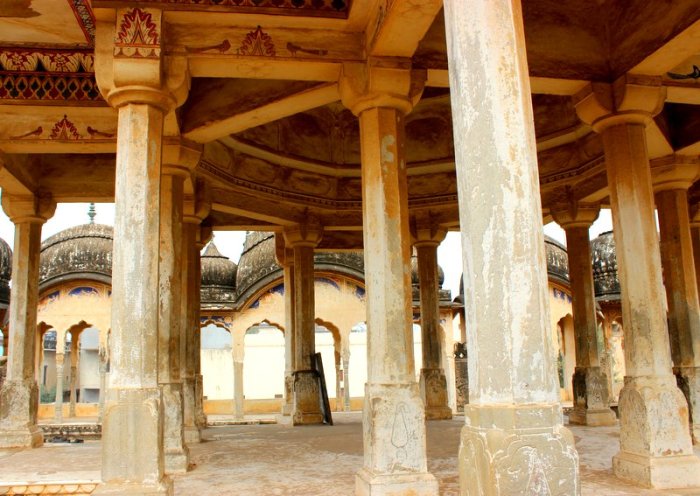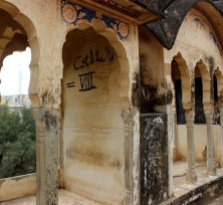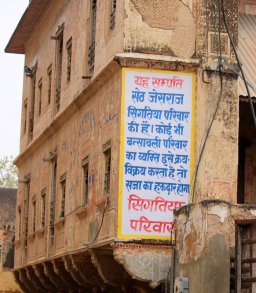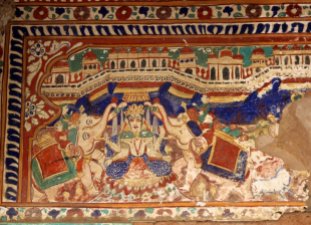Ilay Cooper’s book on Shekhawati set me off on an extraordinary trip to that extraordinary place in January this year. I had to wait for nearly 6 months, though, before I felt ready to write about it — so overwhelming were my thoughts and emotions. This post on Bissau is the seventh of 8 posts in the series on “The Painted Towns of Shekhawati”. If you haven’t read the introduction to Shekhawati’s history (and the series), I recommend that you do so now, before proceeding further. If you have already done so, then dive straight into the post.
When I set out for Bissau on my third day of exploring the painted towns of Shekhawati, I had no idea of the surprises awaiting me.
The first was the drive to Bissau from Nawalgarh. Gone was the flat landscape (with an occasional hillock breaking the monotony) that I had seen on my previous days in the region. Instead, there were stretches of gentle, undulating sand dunes.
The second was Bissau itself or rather the state the town was in — it was clean with recently swept roads, no rubbish heaps or plastic bags lying around. After having seen filthy towns like Nawalgarh, Bissau came a pleasant and welcome surprise.
The next surprise was the first painted monument I visited in Bissau — the Sarkari Chhatri. It turned out to be a school, an open air school in fact, with the chhatris serving as classrooms for different grades. A PT class was in progress when I arrived and though I wanted to explore the monument, I baulked at disturbing the students. But the school teachers assured me that it was fine and I went ahead to the accompaniment of curious stares and many giggles from the students.
 And the last surprise were the frescoes themselves, at least some of them. But more about that later on in this post.
And the last surprise were the frescoes themselves, at least some of them. But more about that later on in this post.
Bissau was founded in 1746 by Keshri Singh on the site of an existing village. One of the first things that he did was to build a Fort, Keshargarh, something every self-respecting ruler did. Within 10 years of Keshri Singh’s rule, town walls had been built in Bissau and a special bazaar created for the traders, which brought prosperity to the town.
 In 1799, Keshari Singh’s grandson, Shyam Singh became the thakur or ruler of Bissau and the town’s fortunes changed. Shyam Singh was a greedy ruler who exhorted money from the traders to such an extent that they left the town en masse.
In 1799, Keshari Singh’s grandson, Shyam Singh became the thakur or ruler of Bissau and the town’s fortunes changed. Shyam Singh was a greedy ruler who exhorted money from the traders to such an extent that they left the town en masse.
Not to be content with this, he employed French mercenaries and local thieves and dacoits to loot neighbouring kingdoms. It was only when he died and his heir Hamir Singh took charge, that Bissau’s fortunes changed yet again. One of the first things Hamir Singh did was to win the trust of the traders and bring them back to Bissau.With the return of the traders, prosperous days returned to the town.
Bissau is an attractive town today and while its havelis are no longer as grand as they used to be or even in the condition they used to be, many of the original frescoes survive. Many of the havelis are locked up and have no signs indicating what they are called. The few that are inhabited had high gates that gave a clear “Keep Out” sign to someone interested in seeing the frescoes. This meant that all the frescoes that I saw in Bissau were those painted on the exterior walls or visible from outside. I didn’t mind that for there was enough variety to keep me engaged and happy.
 The Bissau frescoes are not flashy or very finely done, but the colours are vibrant — especially the indigo blues and the reds/maroons. Though turquoise, yellow ochre and malachite green have been used in some of the murals, but indigo, almost ultramarine, blues and reds/maroons dominated. The subject/theme of the painting ranged from religious to local history to saints to birds to erotica.
The Bissau frescoes are not flashy or very finely done, but the colours are vibrant — especially the indigo blues and the reds/maroons. Though turquoise, yellow ochre and malachite green have been used in some of the murals, but indigo, almost ultramarine, blues and reds/maroons dominated. The subject/theme of the painting ranged from religious to local history to saints to birds to erotica.
 Yes, erotica. Though I had known from Ilay Cooper’s book that many of the havelis had erotic art on their walls, I had not come across any till I visited Bissau. These frescoes are not placed in plain view and it was sheer luck that I stumbled upon the first one — I was walking by a haveli and I still can’t recall what prompted me to look up. High up and under the eaves, sandwiched between a panel showing a horse rider and a panel showing a camel rider was the first one. And then some distance ahead was the second and then the third and so on… all hidden from plain view.
Yes, erotica. Though I had known from Ilay Cooper’s book that many of the havelis had erotic art on their walls, I had not come across any till I visited Bissau. These frescoes are not placed in plain view and it was sheer luck that I stumbled upon the first one — I was walking by a haveli and I still can’t recall what prompted me to look up. High up and under the eaves, sandwiched between a panel showing a horse rider and a panel showing a camel rider was the first one. And then some distance ahead was the second and then the third and so on… all hidden from plain view.
Presenting a set of 42 photographs from the painted havelis and Chhatris of Bissau. Clicking on any of the captioned photographs will start a slide show. Though you can start the slide show from any photograph, I recommend that you begin with the first, and once you have finished seeing the photos, don’t forget to come back to read the rest of the post.
Back in my hotel that evening, the manager came over to ask how my day was, what places I had visited and what I found interesting that day. When I mentioned the part about how clean Bissau was, he said that Bissau had always been different from the other Shekhawati towns in this regard and the local administration took a lot of care in keeping the surroundings clean.
I liked Bissau. a lot, in fact. Though the frescoes of Bissau were not as dazzling as Fatehpur, or as varied as Nawalgarh, they still had a charm and uniqueness of their own. It helped that Bissau was clean and I could actually wholly concentrate on the frescoes, instead of watching where my foot was going to land next. It also helped that Bissau was such a friendly place full of welcoming and curious smiles, and no one asked which country I was from. 🙂
For this reason alone, I declare Bissau to be my favourite place in Shekhawati. 🙂
Notes:
- Bissau is in the Jhunjhunu district of Rajasthan and is about 60 km and a 90-minute drive from Nawalgarh, my base in Shekhawati.
- Many of the havelis are locked up and empty. Some have just been abandoned, while some have caretakers who will allow you to see them for a small fee. For your own safety, I would advise extreme caution in deciding to enter such havelis.
- While most caretakers/watchmen of the havelis will ask for a token amount upfront before you see the haveli, some may not. In such cases, I would suggest that you pay them something when you leave.
Join me on Twitter, Facebook and Instagram as I explore Shekhawati and other places.
The Painted Towns of Shekhawati Series: Introduction | Nawalgarh | Dundlod | Mandawa | Lakshmangarh | Fatehpur | Bissau | Mahensar
Other Shekhawati-related posts: The Shekhawati trip planner | The painter of murals | Messages on the wall: The graffiti of Nawalgarh | The stepwell at Lohargal | The garbage well |











































Beautiful!! the colours are simply stunning! and the depiction isnt as clear and well drawn as in the earlier towns, but the colours make up for that! i love the idea of an open air school in a painted chhatri like this! so much fun that would be no? i just hope the paintings survive….
LikeLiked by 2 people
I loved the idea of a chhatri being used for something constructive like a school. I saw too many chhatris and wells being used as a space for young men to loiter or loll about. But there are concerns — I didn’t see any toilet; what happens in summer and how do the kids manage in the heat or rain for that matter?
The paintings are there, but just about. And the sooner you go to see them, the better. 😦
LikeLike
by the way, forgot to add before.. the Hari-Hara took me back to Sankaran Kovil. Will post that soon!
LikeLiked by 1 person
Waiting for that post. Tell me, there any such thing as Krishna-Hara? For instead of Vishnu, it is Krishna who is depicted here. I know that Krishna is an avatar of Vishnu, but still…
LikeLike
Beautiful. Both the pictures and the writing. For some reason, I felt this profound sadness while going though the pictures. Glory slowly disintegrating into dust. Good to know that it is kept clean. I hope for some restoration to take place 🙂
LikeLiked by 1 person
The frescoes do have that effect on you. I felt the same when I travelled from town to town visiting haveli after haveli. In the courtyard of one haveli in Fatehpur, three walls had stunning frescoes. The fourth was damaged with soot from the kitchen smoke and laying of pipes for a bathroom for the caretaker who lived there. I can’t tell you how terrible it was to see that. 😦
All the havelis are private residences. Some have been turned into hotels and a few into museums. If any restoration has been done, it has been their own initiative. The government can neither intervene nor does it have the resources to do so. The only way forward that I can see is for some kind of a public-private partnership that can at least maintain it to some basic minimum level if not restore it.
LikeLike
Also, I loved the Meera – Krishna Fresco best among all. It is so simple and yet captures the essence of their relationship ( I totally understand how it can move you to tears! )
It would be great if you can add some logistics (where you stayed, means of transport, itinerary – that sort of thing) of your travels – perhaps as a footnote. The small towns of Rajasthan intimidate a novice from Southern India like me 🙂
LikeLiked by 1 person
Mira and Krishna was beautiful and like you said, it captures the essence of their relationship in that one simple frame.
Thanks for the suggestion, Divya. I will be putting a “Shekhawati Trip Planner” post sometime next week with all the details you have requested for. Watch this space 🙂
LikeLike
Lovely.
LikeLiked by 1 person
Thank you 🙂
LikeLike
Amazing post.. i am so worried that the series will get over soon.
LikeLiked by 2 people
Thank you, Lata. Yes, there is only one more painted town to write about for now. But there are other posts from Shekhawati in the pipeline. Besides, did you think this would be my only trip there? There are so many other painted towns to explore. I will go back; I just don’t know when. 🙂
LikeLiked by 1 person
Bissau and Dundlod – rank as my favorites. The fresco detail of Mira-Krishna gave me a lump in my throat!
LikeLiked by 1 person
The Mira and Krishna fresco is indeed special and I found tears welling up in my eyes when I first saw it. This fresco also seems to be the favourite for many people; I’ve got mail requests from people asking if I could share the image with them !
So, Bissau and Dundlod, eh? Let’s see what your reaction to the red and gold paintings of Mahensar will be like 🙂
LikeLike
I just picked on this post in the series and loved it. The paintings are not as well preserved or even varied as Nawalgarh, the other post that I have read so far, but they still made me smile. Especially the calasses that go on under the painted chatris! I have posted comments under some pics. Wonder where they will show up. FB?
LikeLiked by 1 person
Bissau is my favourite town. Yes, the murals are not of the quality that one can see in some of the other towns but the Mirabai and Shankaracharya won it for me. Their renditions are so unique !
And who can resist school children, and smiling children that too? 🙂
The comments that you have posted ti individual photographs will appear there as will my replies.
LikeLike
Great Post
LikeLiked by 1 person
Thank you, Mukul Chand. Hope you have liked the post enough to keep visiting and reading the rest of the posts. 🙂
LikeLiked by 1 person
Welcome. Will revisit when you post again.
LikeLike
The saint portrayed in the 39no photo – I believe the famous Bhakti saint of Bengal Sri Chaitanyadev Mahaprabhu. The river shown is Ganga (again my guess) on whose bank an ancient town Nabadwip lies. Just like Varanasi, this town is known as epitome of Hindu religious pedagogy. On 15th century around, Mahaprabhu born in this town. He was the main architect of spreading Vaishnavism in eastern India. I presume while doing transactions in Calcutta or in larger Bengal, the builder of this Haveli got influenced by the ‘Gaudiya Vaishnavism’ of Mahaprabhu and so he got his image painted.
Btw, ISCON has built their HQ at Mayapur which is just across the river of Nabadwip.
LikeLike